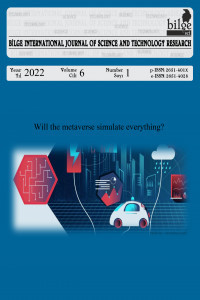Bilişsel Radyo Sistemleri için Özdeğer Tabanlı Algılama Yöntemlerinde Performans Analizi
Algılama teorisi, Bilişsel radyo, Spektrum algılama, Tracy-widom dağılımı
Performance Evaluation of Eigenvalue Based Detection Methods for Cognitive Radio Systems
___
- C. Çiflikli , F.Y .Ilgin; Covariance based spectrum sensing with studentized extreme eigenvalue , Technical gazette (accepted papers in press,2018)
- C. Charan, R. Pandey, Eigenvalue Based Double Threshold Spectrum Sensing Under Noise Uncertainty for Cognitive Radio, Optik - International Journal for Light and Electron Optics . 127,15, (2016), pp 5968–5975.
- D. Bhargavi , C. Murthy , Performance comparison of energy, matched-filter and cyclostationarity-based spectrum sensing, in: Proceedings of IEEE Eleventh International Workshop on Signal Processing Advances in Wireless Communications (SPAWC) ,Morocco, 2010, pp. 1–5.
- D. Guo , Y. Wu , S . Shamai ,S. Verdu , Estimation in Gaussian Noise: Properties of the Minimum Mean-Square Error , IEEE Transactions On Information Theory, 57, 4,( 2011), pp.2371-2385.
- I. Sobron ,P. Diniz , W. Martins , Velez M.; Energy detection technique for adaptive spectrum sensing , IEEE Trans. Commun. 63 (3) (2015) 617–627
- J. Mitola, Jr. Maguire, G.Q. Cognitive Radio: making Software Radios More. IEEE Pers. Commun.,6, 4(1999), pp. 1318.
- L. Shi-Qi , H. Bin-Jie , W. Xian-Yi , Hierarchical Cooperative Spectrum Sensing Based on Double Thresholds Energy Detection , IEEE Communications Letters,16, 7, (2012), pp.1096-1099.
- M. Jin , Q. Guo ,J. Xi , Y. Youming Li ,Y. Yu , Huang D. Spectrum Sensing Using Weighted Covariance Matrix in Rayleigh Fading Channels, IEEE Transactıons On Vehıcular Technology, 64, 11, (2015), pp. 5137-5148.
- N. Pillay , H.J. Xu, Blind Eigenvalue-Based Spectrum Sensing for Cognitive Radio Networks. IET Comm. 6,11 (2011), pp.1388-1396.
- S. Chatterjee, A.Banerjee , Acharya T.; Maity S. P, Fuzzy c-means clustering in energy detection for cooperative spectrum sensing in cognitive radio system, in: Proceedings of Multiple Access Communications (MACOM) Sweden, 8715, (2014), pp. 84–95.
- S. K.; Signal Processing for Cognitive Radios. John Wiley & Sons, Inc. Melbourne,2014.
- S.R Deo , On the Tracy-Widom Approximation of Studentized Extreme Eigenvalues of Wishart Matrices. Journal of Multivariate Analysis 147, (2016), pp.265.
- T. Ratnarajah, R. Vaillancourt ; Alvo M.; Eigenvalues and condition numbers of complex random matrices, SIAM J. Matrix Anal.Appl., 26, 2(2005), pp. 441–456. Y. Zeng , Y.C. Liang , Covariance based signal detections for cognitive radio, in: Proc IEEE International Symposium on and New Frontiers in DynamicSpectrum Access Networks (DySPAN 2007) , Dublin, Ireland, April 2007, 2007, pp. 202–207.
- Z. Xinzhi , G. Feifei , C.Rong ,J. Tao ; Matched filter based spectrum sensing when primary user has multiple power levels , China Commun. 12 (2) (2015) , pp.21–31.
- ISSN: 2651-401X
- Yayın Aralığı: Yılda 2 Sayı
- Başlangıç: 2017
- Yayıncı: Kutbilge Akademisyenler Derneği
Yapay Sinir Ağları ile Tr81 Bölgesi Yıllık Elektrik Enerjisi Tüketiminin Tahmini
Yasemin KOCADAYİ, Okan ERKAYMAZ, Rukiye UZUN
Bakır Esaslı Rodaj Disklerinin Performansı
Mehmet KAHRAMAN, Habibullah BİLGE, Murat KARAAĞAÇ, Sabri ÖZTÜRK
Mete Yağanoğlu, Murat Kayabekir, Cemal KÖSE
Kesir Dereceli Kontrol Sistemlerinde Referans Modele Dayalı PID Kontrolör Tasarımı
Tufan DOĞRUER, Ali YÜCE, Nusret TAN
Sercan BULBUL, Cevat INAL, Omer YILDIRIM, Fuat BASCIFTCI
Development of the road analysis system to provide the fuel efficiency awareness in the vehicles
Bilişsel Radyo Sistemleri için Özdeğer Tabanlı Algılama Yöntemlerinde Performans Analizi
Cebrail ÇİFLİKLİ, Fatih Yavuz ILGIN
Authentication with Iris Recognition Based on A 3-Tier Security Analysis Approach
